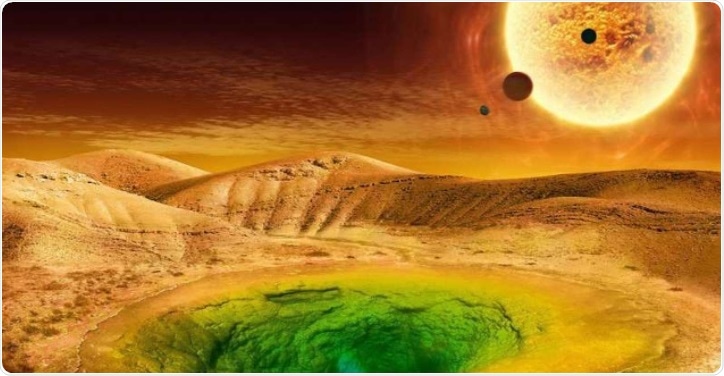While searching for signs of life, scientists often look for chemicals, biosignatures, or phenomena that suggest the presence of current or past life. However, it is not always the case that signs of life on Earth are also signs of life in other planetary ecosystems. How to find life in systems that do not resemble those on Earth?

Artist’s conception of where life might be found on a distant planet. Image Credit: NASA.
Led by Professor Chris Kempes from Santa Fe Institute, a group of researchers has created a new ecological biosignature that could enable scientists to identify life in a variety of ecosystems. The groundbreaking study has been published in a special edition of the Bulletin of Mathematical Biology dedicated to famous mathematical biologist James D. Murray.
The new study is based on the premise that chemical ratios or stoichiometry can be used as biosignatures.
Since living systems display strikingly consistent ratios in their chemical make-up, we can use stoichiometry to help us detect life.”
Chris Kempes, Professor, Santa Fe Institute
However, as Simon Levin, a member of the SFI Science Board and a contributor, states, “the particular elemental ratios we see on Earth are the result of the particular conditions here, and a particular set of macromolecules like proteins and ribosomes, which have their own stoichiometry.”
How to extrapolate these elemental ratios outside the life seen on Earth? The team tackled the issue by developing two lawlike patterns, two scaling laws, which are entangled in elemental ratios observed on Earth. The first is that stoichiometry differs from the cell size of different cells.
Protein concentrations in bacteria, for instance, decrease as cell size grows, while RNA concentrations rise. The second is that the abundance of cells in a given system follows a power-law distribution.
The third, which is a result of incorporating the first and second into a basic ecological model, is that the ratio of particle elemental abundance to elemental abundance in the environmental fluid is a function of particle size.
If the first finding (that elemental ratios change with particle size) is a chemical biosignature, the third finding is a recent ecological biosignature.
When biosignatures are considered in terms of fluids rather than discrete particles or chemicals, it can be observed that the chemical abundances in living systems express themselves in statistical ratios between the particle and the environment.
These broad mathematical trends can manifest themselves in coupled systems that vary dramatically from Earth. Finally, the theoretical concept is intended for use in future planetary missions.
“If we go to an ocean world and look at particles in context with their fluid, we can start to ask whether these particles are exhibiting a power-law that tells us that there is an intentional process, like life, making them,” said Heather Graham, Deputy Principal Investigator at NASA’s Lab for Agnostic Biosignatures, where she and Kempes both work together.
But resorting to this implemented move requires particle size-sorting technology, which is currently not available for spaceflight. However, the theory is complete, and when the technology arrives on Earth, it can be sent to the frozen seas beyond the solar system with a groundbreaking new biosignature in hand.
Source:
Journal reference:
Kempes, C. P., et al. (2021) Generalized Stoichiometry and Biogeochemistry for Astrobiological Applications. Bulletin of Mathematical Biology. doi.org/10.1007/s11538-021-00877-5.